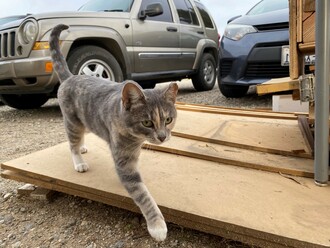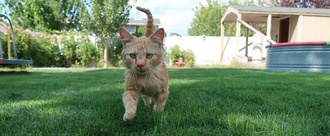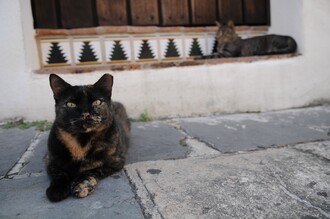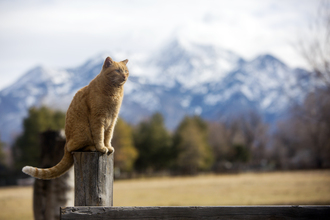-
Virginians support humane methods for managing catsWe, residents of Virginia, support this safe, humane, and cost-effective method for managing the cats living in our communities. Please pass legislation to affirm the legality of TNR so we can reduce the number of cats entering and dying in our animal shelters. With enough signatures, we can ensure stronger support for these lifesaving programs. Please sign and share this petition today.800 of 1,000 SignaturesCreated by April M.

-
Help save our lost and homeless cats in the Flathead Valley.We have cats in our valley that are falling through the cracks. When the county shelter, local humane society and Kitty Mom’s rescue are full (which is frequently) we have no safety net to support cats that are turned away and left on the streets.191 of 200 SignaturesCreated by Kitty L.
-
Apoye programas de gatos comunitarios en Riverside¿Porque esto es importante? Los gatos de la comunidad (también conocidos como gatos callejeros o ambulantes) corren el riesgo de perder la vida simplemente porque han establecido un hogar en su comunidad. En muchos casos, son llevados a refugios locales, donde es poco probable que los adopten porque muchos de ellos no están socializados con la gente. Muchos de estos gatos están prosperando viviendo dentro su cominidad porque alguien en su comunidad los cuida. Ahí es donde entran los programas comunitarios para gatos. Estos programas usan Capturar, Esterilizar y Soltar (CES) para salvar gatos. El proceso es simple: los gatos de la comunidad son atrapados, evaluados por veterinarios, vacunados, esterilizados o castrados. Se les cortan un poco de la puntita de una oreja para identificarlos como esterilizados y devueltos a sus comunidades, sin poder tener gatitos. Hace tres años, en asociación con Best Friends, el Departamento de Servicios para Animales del Condado de Riverside adoptó este enfoque al dar la bienvenida a un programa comunitario para gatos en su ubicación de Coachella Valley Animal Campus. A principios de 2020, se esterilizaron y castraron hasta 10,000 gatos elegibles a través del programa. El trabajo continúa hoy a menor escala debido a las limitaciones físicas y financieras provocadas por la pandemia, dejando a muchos miembros de la comunidad y gatos sin este recurso necesario. Puede ayudar a salvar las vidas de los gatos de la comunidad y apoyar a las personas que los cuidan, abogando por programas comunitarios de gatos y otros esfuerzos para salvar vidas que se implementarán en todo el condado de Riverside. ¡Gracias por apoyar a los gatos comunitarios en su vecindario y por todo lo que hacen por los animales!116 of 200 SignaturesCreated by Carol R.

-
Saving Innocent Cats in Utah CountyIn order to create compassionate no-kill communities and achieve no-kill for cats nationwide, we need communities to support lifesaving programs like Trap-Neuter-Return [TNR]. The process is simple: cats are caught (often by volunteers), evaluated by veterinarians, vaccinated, spayed or neutered, and returned to their original outdoor homes, unable to have kittens. These programs are also proven to be the most cost-effective, veterinarian-approved, and animal-friendly solution for controlling and reducing free-roaming cat populations.464 of 500 SignaturesCreated by Kassie C.
-
Street Cats Need our HelpIn 2016 I found the West Orange TNVR Program. It took a year and a half to get this approved and an ordinance allowing us to TNVR in West Orange, NJ. Unfortunately, surrounding towns do not do any TNR and it is sad how the population is growing and how these animals are suffering. This can be address with support from our legislatures. West Orange TNVR receives no financial support from the township. We depend strictly on donations and fundraisers. We are all volunteers and home based. To date we have spay/neutered 1086 street cats and adopted 623 kittens and adult cats. We have had inoculation, amputations, wounds and many URI We do all we can to save a life.487 of 500 SignaturesCreated by Judith S.
-
Apoya a los animales y la comunidad de Laredo¿Porque esto es importante? Usted es una parte fundamental para garantizar que las mascotas y las personas tengan acceso a programas y recursos positivos. Es importante que sus representantes sepan que salvar gatos y perros es importante para la gente de Laredo. La buena noticia es que puede ser parte del apoyo a programas positivos que funcionan en Texas. Algunos ejemplos incluyen la programación comunitaria para gatos (ver más abajo), la programación de crianza (para proporcionar alojamiento temporal a las mascotas antes de encontrar sus hogares permanentes) y servicios y recursos progresivos de campo para garantizar que las personas tengan lo que necesitan para mantener a sus mascotas. La comunidad en su conjunto (refugio, mascotas, personas) puede abogar por estos programas y más recursos para crear un cambio para los animales y quienes los cuidan. Más sobre la programación comunitaria de gatos: Los gatos de la comunidad (también conocidos como gatos callejeros o comunitarios) corren el riesgo de perder la vida simplemente porque han establecido un hogar al aire libre. En muchos casos, son llevados a refugios locales, donde es poco probable que los adopten porque muchos de ellos no están socializados con la gente. Ahí es donde entran los programas comunitarios para gatos. Estos programas usan Atrapar- Esterilizar- Regresar (AER o TNR, por sus siglas en inglés) para salvar gatos. El proceso es simple: los gatos de la comunidad son atrapados, evaluados por veterinarios, vacunados, esterilizados o castrados. Se les cortan un poco de la puntita de una oreja para identificarlos como esterilizados y devuelven a sus comunidades, sin poder tener gatitos. Y estos programas ya están funcionando en todo el país. Los habitantes de Laredo merecen los programas de AER (Atrapar- Esterilizar- Regresar), que son respetuosos con los animales, eficiente en costos y reducen la carga que pesa sobre el refugio de animales. -------------------------------- Al abogar por estos programas y continuar colaboración con otras organizaciones comunitarias, puede ser parte de la creación de una comunidad más saludable para las mascotas y las personas. Juntos podemos hacer cambios sostenibles que salven vidas mientras creamos un marco de apoyo para las mascotas de Laredo y las personas que se preocupan por ellas. Gracias por apoyar a los perros y gatos de Laredo.113 of 200 SignaturesCreated by Carol R.

-
Support Community Cat programs in RiversideCommunity cats (aka stray or free-roaming cats) risk losing their lives simply because they've made a home in the outdoors. In many cases, they are brought to local shelters, where they are unlikely to get adopted because many of them aren't socialized to people. Many of these cats are thriving living outdoors because someone in their community cares for them. That's where community cat programs come in. These programs use trap-neuter-return (TNR) to save cats. The process is simple: Community cats are trapped, evaluated by veterinarians, vaccinated, spayed or neutered, ear-tipped, and returned to their outdoor homes, unable to have kittens. Three years ago, in partnership with Best Friends, Riverside County Dept. Of Animal Services took on this approach by welcoming a community cat program at their Coachella Valley Animal Campus location. By early 2020, as many as 10,000 eligible cats were spayed and neutered through the program. The work continues today on a smaller scale due to physical and financial limitations brought on by the pandemic, leaving many community members and cats without this necessary resource. You can help save the lives of community cats and support the people who care for them, by advocating for community cat programs and other lifesaving efforts to be implemented throughout Riverside County. Thank you for supporting community cats in your neighborhood, and for everything that you do for the animals!812 of 1,000 SignaturesCreated by Carol R.

-
Los Ángeles apoya a su comunidad y a sus gatosCasi 10 años después de que el Consejo Municipal de Los Angeles votaron para hacer de la ciudad una comunidad donde no se matan a perros o gatos innecesariamente, la lucha continúa. Aunque el umbral del 90% se alcanzó para los perros hace cuatro años, los esfuerzos para salvar vidas de los gatos han sido mucho más desafiantes. Sin embargo, un programa actualmente en consideración probablemente empujaría a Los Angeles a la cima. La mayor barrera para salvar a más gatos ha sido una orden judicial que impide a la Ciudad de participar en los programas de CES (Capturar, Esterilizar y Soltar). Como resultado, la cantidad de gatitos que ingresan a los refugios de Los Angeles, a aumentando en los últimos años, agotando los recursos disponibles. El mes pasado, la Ciudad público los detalles de su tan esperado programa para gatos de la ciudad, que asigna fondos para la esterilización de 20,000 gatos que deambulan libremente al año, además de los fondos ya asignados para las mascotas de los residentes. El proceso es simple: los gatos son capturados, evaluados por veterinarios, esterilizados, vacunados y devueltos a su comunidad. Esto promete ser un cambio de juego sin obstaculizar ninguno de los avances ya realizados -- revocando la orden judicial y allanando el camino para que Los Ángeles se convierta en la comunidad más grande del país en donde no se matan a perros y gatos innecesariamente.120 of 200 SignaturesCreated by Carol R.

-
Protect Alaska's community catsHelp support saving the lives of community cats by advocating for lifesaving programs in your area. Please sign and share this petition to show that you support safe, humane and positive solutions for cats living in your community. Current state rules and regulations severely hamper any lifesaving efforts focused on community cats. Alaska's Board of Game has been considering rule changes that could impact cats and the people who care for them. These changes have been pushed to early 2022. Alaska’s residents deserve TNVR (trap-neuter-vaccinate-return) programs, which are animal-friendly, cost-effective, and reduce the burden and bureaucracy placed on the state’s animal shelters. The process is simple: Community cats are trapped, evaluated by veterinarians, vaccinated, spayed or neutered, ear-tipped, and returned to their outdoor homes, unable to have kittens. The simple truth is that current methods of animal control relative to community cats are expensive, ineffective and often inhumane. Rule changes allowing TNVR programs would be better for the cats, for public health and for the wildlife we all want to protect.635 of 800 SignaturesCreated by Keiko B.
-
Shelter Based Trap-Neuter-Vaccinate-Return ProgramWe are asking for support from our city to help this program grow into a much needed shelter based operation.60 of 100 SignaturesCreated by Rebecca S.
-
TNR in Lebanon MOObviously, the biggest benefit of TNR is reducing the feral cat population. Since they can’t reproduce, the size of the colony shrinks over time. TNR also reduces nuisance behavior, such as fighting and spraying. The cats generally are healthier and less likely to spread diseases since they get vaccinated as part of the TNR process. The cats continued presence helps keep rodents under control. Trap-Neuter-Return is successfully practiced in hundreds of communities and in every landscape and setting. It is exactly what it sounds like: Cats are humanely trapped and taken to a veterinarian to be neutered and vaccinated. After recovery, the cats are returned to their home—their colony—outdoors. Kittens and cats who are friendly and socialized to people may be adopted into homes. Grounded in science, TNR stops the breeding cycle of cats and therefore improves their lives while preventing reproduction. It is a fact that the removal and killing of outdoor cats that animal control has been pursuing for decades are never-ending and futile. Since feral cats are not adoptable, they are killed in pounds and shelters. With a successful program like Trap-Neuter-Return to turn to, it’s hard to believe that animal control agencies continue to kill cats, even though that approach has shown zero results. It is time to put an end to catch and kill. Trap-Neuter-Return provides a life-saving, effective solution for these beautiful, independent cats. Colonies that are involved in TNR diminish in size over time. During an 11-year study of TNR at the University of Florida, the number of cats on campus declined by 66%, with no new kittens being born after the first four years of operation. A study of the impact of TNR on feral cat colonies in Rome, Italy, also observed colony size decrease between 16% and 32% over a 10-year period. Trap-Neuter-Return quickly stabilizes feral cat populations by instantly ending reproduction and by removing socialized cats from the colony. A TNR program at Texas A&M University neutered 123 cats in its first year and found no new litters of kittens the following year. Over the course of the same study, 20% of the cats trapped were found to be socialized stray cats and adopted. I personally worked with Allied Cats of Columbus in Columbus, GA, where I saw the benefits of the reduction of cats being euthanized by animal control and a decrease in the adoptions.119 of 200 SignaturesCreated by Lea'Ona L.
-
Decriminalize TNR in Allen TXTNR quantifiably reduces suffering and helps to stabilize feral and community cat populations. It also serves a springboard for a broader conversation about spay and neuter for companion animals. By getting a single city in North Texas to allow for TNR, we can create momentum to get other cities to follow suit. Doing so will not only reduce city budgets in dealing with kittens and nuisance complaints, but also local animal rescues and advocacy groups. Less breeding -means - fewer kittens - means fewer resources spent by rescues. It can also help reduce compassion fatigue in local animal service and rescue organizations. At the end of the day, TNR reduces animal suffering without any negative consequences for city governments and a multitude of benefits for communities.77 of 100 SignaturesCreated by Jon T.



.jpg)



.jpg)

.jpg)